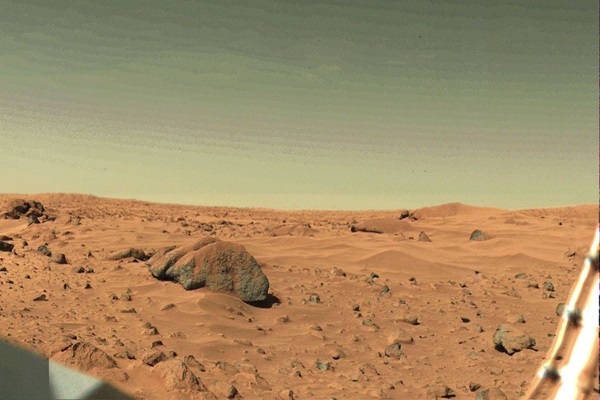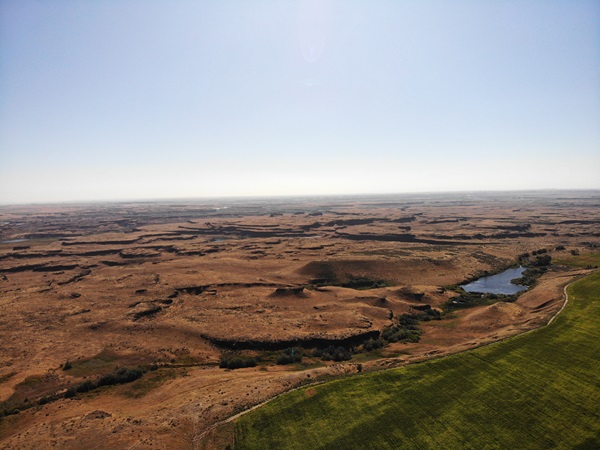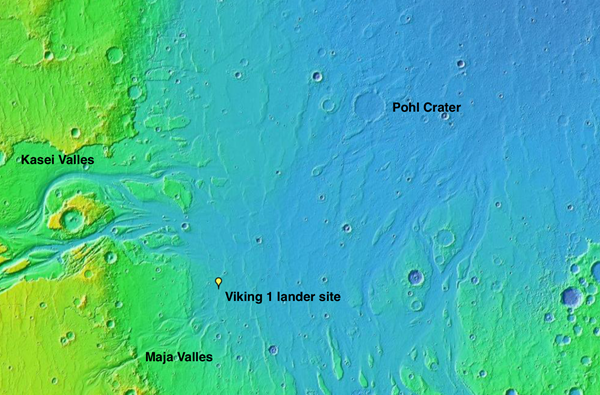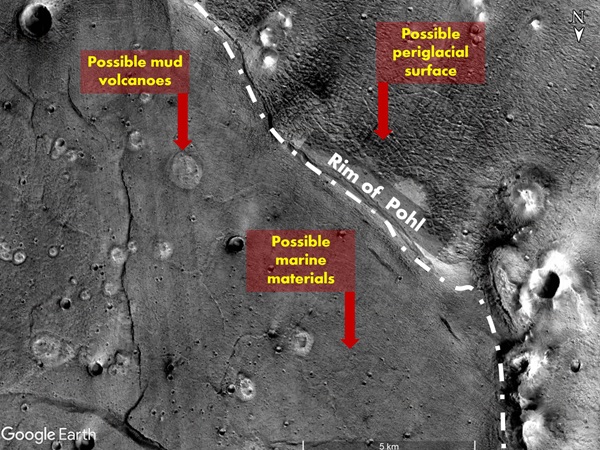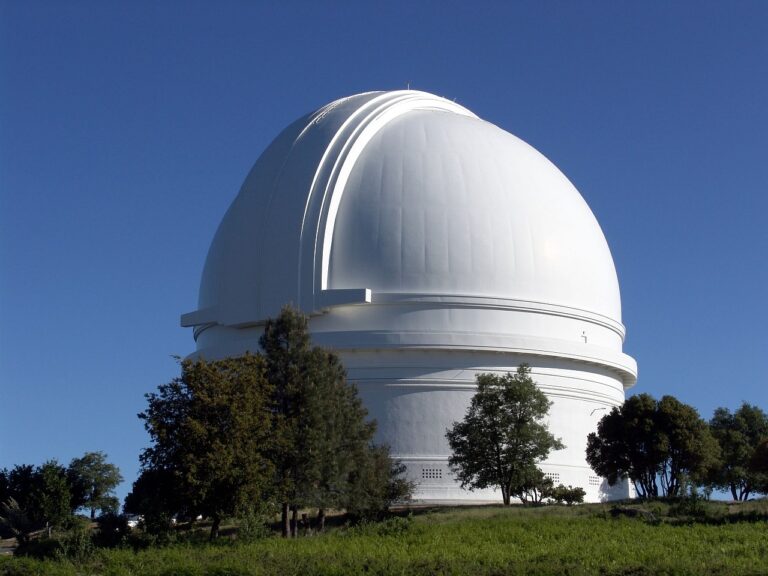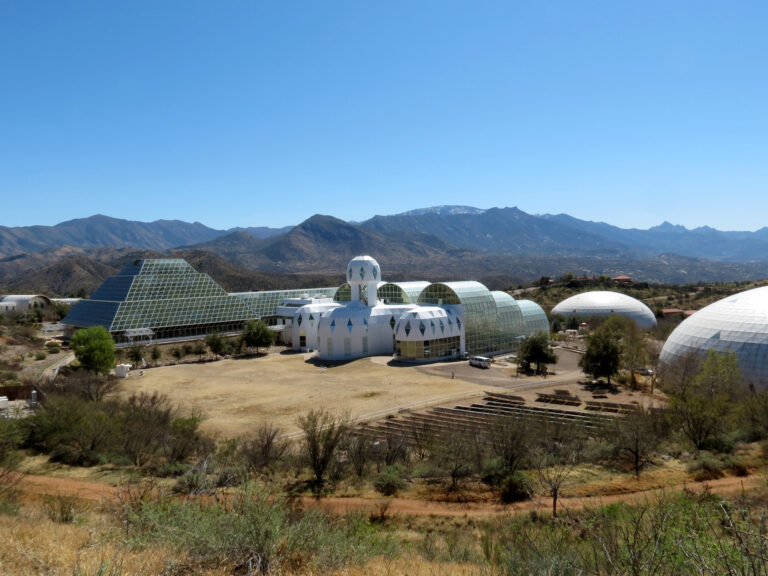Key Takeaways:
Around 3.4 billion years ago, when Mars was a warm, wet world, an asteroid several kilometers wide tore through its thin air and crashed into a shallow sea, leaving an expansive crater on the seafloor. The impact sent a wave of water up to 800 feet (250 meters) high surging inland for hundreds of miles, leaving behind a layer of debris hundreds of feet thick.
That’s the scenario outlined in a paper published Dec. 1 in the journal Scientific Reports by a team of researchers who think they have identified the impact crater that the asteroid left behind. Their analysis points to Pohl, a 68-mile-wide (110 kilometers) crater lying on the plains of Chryse Planitia, as the source of this catastrophic event — a martian analog to the famous Chicxulub impact off the Yucatan Peninsula that spelled the beginning of the end of the dinosaurs.
What’s more, we may have already explored the remains of this megatsunami. The team’s analysis indicates that the Viking 1 lander, which became the first spacecraft to successfully touch down on the Red Planet on July 20, 1976, landed right on top of the deposit from this megatsunami. The new findings help explain the landscape Viking 1 found — and suggest that it has a much more interesting history of water than scientists initially thought.
A history of deluges
When NASA chose Viking 1’s landing site, they were hoping for a landscape formed by a different type of watery inundation, one with landforms sculpted by flowing water. Imagery from early Mars missions showed that the region is marked by massive channels, thought to be carved out during megafloods that sprung forth from underground aquifers and rushed downhill to fill a vast northern sea. Viking 1 landed near terrain that, from orbit, includes features that were clearly once islands, streamlined by the water that flowed past them.
“The presence of these channels immediately kind of like rang a bell — you know, surface channels like water, water likes life,” Alexis Rodriguez, a researcher at the Planetary Science Institute in Tucson and the team leader, tells Astronomy.
But when Viking 1 landed, there were none of the streamlined features or channels that would have indicated fast flows of water. Instead, Viking was surrounded by mostly flat, boulder-strewn terrain. Scientists wondered if perhaps the craft had landed atop a blanket of ejecta thrown out from an impact crater, or perhaps on a field of lava flows. But there weren’t enough craters around to support the hypothesis of an ejecta, which would likely have to be several meters thick, says Rodriguez. And from the lander’s limited viewpoint, there was no clear evidence of lava deposits, either.
Thus, Rodriguez and his colleagues write, Viking 1’s landing site was “an enduring mystery.” But these features can be explained by a massive tsunami caused by an impact, they argue.
In a 2016 study, Rodriguez and colleagues had argued that the waves from two megatsunamis, perhaps caused by impacts just a few million years apart, had reshaped the shorelines of an ancient martian ocean. In between the impacts, the martian ocean had receded as sea levels fell by about 1,000 feet (300 meters). The younger megatsunami, the team had found, was likely linked to Lomonosov, a 90-mile-wide (150 km) crater on the northern plains of Mars. But the impact that triggered the older megatsunami — the one that had swept over the Viking 1 site — remained in question.
In their new study, the team identify a fitting candidate: Pohl Crater, located roughly 660 miles (900 km) northeast of the Viking 1 landing site. The timeline matches up, too. Pohl lies on top of sinuous terrain that was formed by the megaflood outflows (which in turn formed the northern ocean). But Pohl itself is covered by a wave of debris from the younger megatsunami.
“Hence, we know that it must have formed after the ocean’s generation and before its disappearance,” Anthony Lopez, a geosciences undergraduate student at Pima Community College in Tucson and an intern working with Rodriguez, tells Astronomy.
The team backed this up with computer models that simulate the physics of the impact to estimate how far up the topography the tsunami would have pushed. This isn’t the same height everywhere — when forced into channels, a tsunami’s raging waters can surge much higher than in flatter regions. “You need a process that can defy gravity,” says Rodriguez. But remarkably, he says, the simulation results were nearly an exact match to the extent of the deposit that the team had identified in satellite data.
Area of interest
The study not only reveals a dramatic story; it also has the potential to reshape the interpretation of Viking 1’s mission. Because there were no signs of running water in the lander’s immediate surroundings, researchers assumed they had missed out on sampling rocks that had potentially been in contact with water — or any life that may have existed in that water. In fact, Viking 1 carried an experiment to detect signs of life in martian soil. The experiment detected some reactivity, but most scientists chalk that up to chemical reactions in the soil, not biological activity.
Still, says Rodriguez, the fact that the Viking site may actually consist of dredged-up ocean sediment washed ashore in a tsunami means that the region — as well as Pohl itself — could be a prime site for further searches for ancient martian life.
“What this study actually provides is not support for the presence of life or otherwise,” Rodriguez cautions. But, he says, “What it shows is that there’s a context of habitability — that the deposit could have transported water that existed in habitable environments for hundreds of millions of years.”

